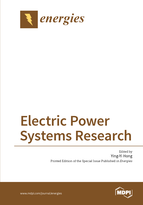Electric Power Systems Research
A special issue of Energies (ISSN 1996-1073).
Deadline for manuscript submissions: closed (15 January 2016) | Viewed by 139746
Special Issue Editor
Interests: smart grid; control and planning for microgrid; intelligent methods applied to power systems
Special Issues, Collections and Topics in MDPI journals
Special Issue Information
Dear Colleagues,
The Edison Electric Light Company, owned by Thomas Edison, developed the first steam-based electric power station on Pearl Street in New York City in 1882. This power station initially supplied electric power to around 3000 lamps for 59 customers. This may have been the first power system in the world. At present, people request utilities to deliver electric power in a stable, reliable, secure and sustainable manner from a generation system through transmission and distribution systems to end-users. Consequently, the need to develop advanced technologies and novel methods applied to the modern power system is essential. Recently, the concept of smart grids incorporating renewables, power electronics-based facility and information/communication technology receives more and more attention. Research on smart grids must be also addressed.
Electric Power Systems Research is a Special Issue in Energies for those who would like to publish original papers about the generation, transmission, distribution and utilization of electrical energy. This Special Issue aims at presenting important results of work in power systems. Works can be applied research, development of new procedures or components, original application of existing knowledge, or new design approaches.
Papers in the relevant area of Electric Power Systems Research, including, but not limited to, the following, are invited:
- power system stability
- power system reliability
- facts applied to power systems
- optimization methods applied to power system studies
- architectures and models for smart grid
- power market
- control, operation and planning of distributed generation resources
- smart home with energy management systems
- microgrid and active distribution network
- virtual power plant and demand response
Prof. Dr. Ying-Yi Hong
Guest Editor
Manuscript Submission Information
Manuscripts should be submitted online at www.mdpi.com by registering and logging in to this website. Once you are registered, click here to go to the submission form. Manuscripts can be submitted until the deadline. All submissions that pass pre-check are peer-reviewed. Accepted papers will be published continuously in the journal (as soon as accepted) and will be listed together on the special issue website. Research articles, review articles as well as short communications are invited. For planned papers, a title and short abstract (about 100 words) can be sent to the Editorial Office for announcement on this website.
Submitted manuscripts should not have been published previously, nor be under consideration for publication elsewhere (except conference proceedings papers). All manuscripts are thoroughly refereed through a single-blind peer-review process. A guide for authors and other relevant information for submission of manuscripts is available on the Instructions for Authors page. Energies is an international peer-reviewed open access semimonthly journal published by MDPI.
Please visit the Instructions for Authors page before submitting a manuscript. The Article Processing Charge (APC) for publication in this open access journal is 2600 CHF (Swiss Francs). Submitted papers should be well formatted and use good English. Authors may use MDPI's English editing service prior to publication or during author revisions.
Keywords
- stability
- reliability
- optimization
- sustainability
Related Special Issue
- Electric Power Systems Research 2017 in Energies (30 articles)






